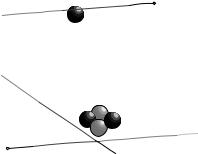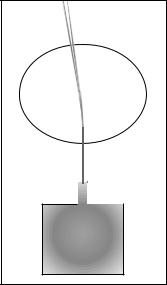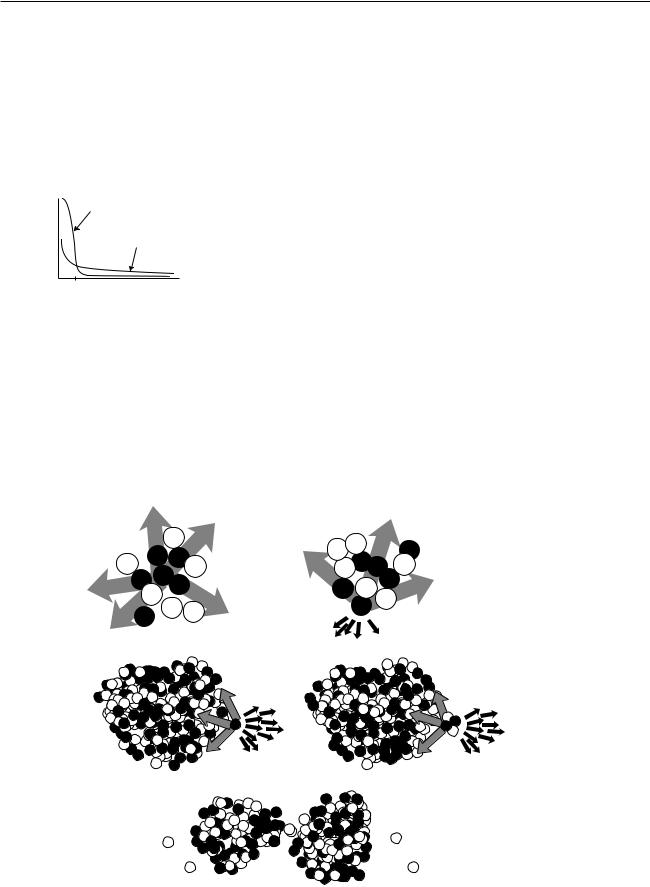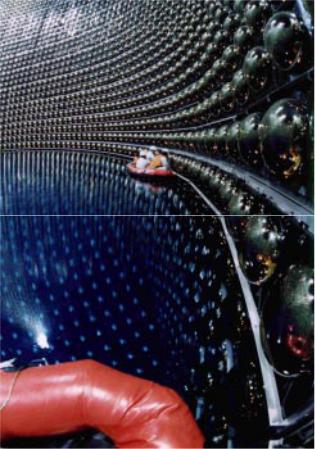
B.Crowell - Electricity and Magnetism, Vol
.4.pdf
Proof of the relationship between atomic number and scattering
The equation above can be derived by the following not very rigorous proof. To deflect the alpha particle by a certain angle requires that it acquire a certain momentum component in the direction perpendicular to its original momentum. Although the nucleus’ force on the alpha particle is not constant, we can pretend that it is approximately constant during the time when the alpha is within a distance equal to, say, 150% of its distance of closest approach, and that the force is zero before and after that part of the motion. (If we chose 120% or 200%, it shouldn’t make any difference in the final result, because the final result is a ratio, and the effects on the numerator and denominator should cancel each other.) In the approximation of constant force, the change in the alpha’s perpendicular momentum component is then equal to F t. The Coulomb force law says the force is proportional
to Z / r 2 . Although r does change somewhat during
the time interval of interest, it’s good enough to treat it as a constant number, since we’re only computing the ratio between the two experiments’ results. Since we are approximating the force as acting over the time during which the distance is not too much greater than the distance of closest approach, the time interval t must be proportional to r, and the sideways momentum imparted to the alpha, F t, is proportional to
 Z / r 2
Z / r 2 r , or Z / r. If we’re comparing alphas scattered
r , or Z / r. If we’re comparing alphas scattered
at the same angle from gold and from copper, then p is the same in both cases, and the proportionality
p Z / r tells us that the ones scattered from copper
at that angle had to be headed in along a line closer to the central axis by a factor equaling Z gold / Z copper . If
you imagine a “dartboard ring” that the alphas have to hit, then the ring for the gold experiment has the same proportions as the one for copper, but it is enlarged by
a factor equal to Z gold / Z copper . That is, not only is the
radius of the ring greater by that factor, but unlike the rings on a normal dartboard, the thickness of the outer ring is also greater in proportion to its radius. When you take a geometric shape and scale it up in size like a photographic enlargement, its area is increased in proportion to the square of the enlargement factor, so the area of the dartboard ring in the gold experiment is
2 greater by a factor equal to  Z gold / Z copper
Z gold / Z copper . Since
. Since
the alphas are aimed entirely randomly, the chances of an alpha hitting the ring are in proportion to the area of the ring, which proves the equation given above.
As an example of the modern use of scattering experiments and crosssection measurements, you may have heard of the recent experimental evidence for the existence of a particle called the top quark. Of the twelve subatomic particles currently believed to be the smallest constituents of matter, six form a family called the quarks, distinguished from the other six by the intense attractive forces that make the quarks stick to each other. (The other six consist of the electron plus five other, more exotic particles.) The only two types of quarks found in naturally occurring matter are the “up quark” and “down quark,” which are what protons and neutrons are made of, but four other types were theoretically predicted to exist, for a total of six. (The whimsical term “quark” comes from a line by James Joyce reading “Three quarks for master Mark.”) Until recently, only five types of quarks had been proven to exist via experiments, and the sixth, the top quark, was only theorized. There was no hope of ever detecting a top quark directly, since it is radioactive, and only exists for a zillionth of a second before evaporating. Instead, the researchers searching for it at the Fermi National Accelerator Laboratory near Chicago measured cross-sections for scattering of nuclei off of other nuclei. The experiment was much like those of Rutherford and Chadwick, except that the incoming nuclei had to be boosted to much higher speeds in a particle accelerator. The resulting encounter with a target nucleus was so violent that both nuclei were completely demolished, but, as Einstein proved, energy can be converted into matter, and the energy of the collision creates a spray of exotic, radioactive particles, like the deadly shower of wood fragments produced by a
Section 2.3 Atomic Number |
51 |

cannon ball in an old naval battle. Among those particles were some top quarks. The cross-sections being measured were the cross-sections for the production of certain combinations of these secondary particles. However different the details, the principle was the same as that employed at the turn of the century: you smash things together and look at the fragments that fly off to see what was inside them. The approach has been compared to shooting a clock with a rifle and then studying the pieces that fly off to figure out how the clock worked.
Discussion questions
A. Why does it make sense that, as shown in the figure, the trajectories that
result in 19° and 20° scattering cross each other?
B. Rutherford knew the velocity of the alpha particles emitted by radium, and guessed that the positively charged part of a gold atom had a charge of about +100e (we now know it is +79e). Considering the fact that some alpha particles were deflected by 180°, how could he then use conservation of energy to derive an upper limit on the size of a gold nucleus? (For simplicity, assume the size of the alpha particle is negligible compared to that of the gold nucleus, and ignore the fact that the gold nucleus recoils a little from the collision, picking up a little kinetic energy.)
C. The diagram showing alpha particles being deflected by a gold nucleus was drawn with the assumption that alpha particles came in on lines at many different distances from the nucleus. Why wouldn’t they all come in along the same line, since they all came out through the same tube?
2.4 The Structure of Nuclei
The proton
The fact that the nuclear charges were all integer multiples of e suggested to many physicists that rather than being a pointlike object, the nucleus might contain smaller particles having individual charges of +e.
Evidence in favor of this idea was not long in arriving. Rutherford reasoned that if he bombarded the atoms of a very light element with alpha particles, the small charge of the target nuclei would give a very weak repulsion.
Perhaps those few alpha particles that happened to arrive on head-on collision courses would get so close that they would physically crash into some of the target nuclei. An alpha particle is itself a nucleus, so this would be a collision between two nuclei, and a violent one due to the high speeds involved. Rutherford hit pay dirt in an experiment with alpha particles striking a target containing nitrogen atoms. Charged particles were detected flying out of the target like parts flying off of cars in a high-speed crash. Measurements of the deflection of these particles in electric and magnetic fields showed that they had the same charge-to-mass ratio as singly-ionized hydrogen atoms. Rutherford concluded that these were the conjectured singly-charged particles that held the charge of the nucleus, and they were later named protons. The hydrogen nucleus consists of a single proton, and in general, an element’s atomic number gives the number of protons contained in each of its nuclei. The mass of the proton is about 1800 times greater than the mass of the electron.
52 |
Chapter 2 The Nucleus |

p |
e |
|
p nn p
e
 e
e
Examples of the construction of atoms: hydrogen (top) and helium (bottom). On this scale, the electrons’ orbits would be the size of a college campus.
The neutron
It would have been nice and simple if all the nuclei could have been built only from protons, but that couldn’t be the case. If you spend a little time looking at a periodic table, you will soon notice that although some of the atomic masses are very nearly integer multiples of hydrogen’s mass, many others are not. Even where the masses are close whole numbers, the masses of an element other than hydrogen is always greater than its atomic number, not equal to it. Helium, for instance, has two protons, but its mass is four times greater than that of hydrogen.
Chadwick cleared up the confusion by proving the existence of a new subatomic particle. Unlike the electron and proton, which are electrically charged, this particle is electrically neutral, and he named it the neutron.
Chadwick’s experiment has been described in detail in chapter 4 of book 2 of this series, but briefly the method was to expose a sample of the light element beryllium to a stream of alpha particles from a lump of radium. Beryllium has only four protons, so an alpha that happens to be aimed directly at a beryllium nucleus can actually hit it rather than being stopped short of a collision by electrical repulsion. Neutrons were observed as a new form of radiation emerging from the collisions, and Chadwick correctly inferred that they were previously unsuspected components of the nucleus that had been knocked out. As described in book 2, Chadwick also determined the mass of the neutron; it is very nearly the same as that of the proton.
To summarize, atoms are made of three types of particles:
|
|
mass in units of |
|
|
charge |
the proton's mass |
location in atom |
proton |
|
|
|
+e |
1 |
in nucleus |
|
neutron |
|
|
|
0 |
1.001 |
in nucleus |
|
electron |
|
|
|
-e |
1/1836 |
orbiting around nucleus |
|
|
|
|
|
The existence of neutrons explained the mysterious masses of the elements. Helium, for instance, has a mass very close to four times greater than that of hydrogen. This is because it contains two neutrons in addition to its two protons. The mass of an atom is essentially determined by the total number of neutrons and protons. The total number of neutrons plus protons is therefore referred to as the atom’s mass number.
Section 2.4 The Structure of Nuclei |
53 |

extra charged plates or magnets for deflecting the beam
– – – |
|
– – – |
|
|
|
|
|
+ + + |
|
|
+ + + |
|
|
||
|
|
|
|
|
|
|
|
oven
vacuum chamber
A version of the Thomson apparatus modified for measuring the mass-to- charge ratios of ions rather than electrons. A small sample of the element in question, copper in our example, is boiled in the oven to create a thin vapor. (A vacuum pump is continuously sucking on the main chamber to keep it from accumulating enough gas to stop the beam of ions.) Some of the atoms of the vapor are ionized by a spark or by ultraviolet light. Ions that wander out of the nozzle and into the region between the charged plates are then accelerated toward the top of the figure. As in the Thomson experiment, mass-to-charge ratios are inferred from the deflection of the beam.
Isotopes
We now have a clear interpretation of the fact that helium is close to four times more massive than hydrogen, and similarly for all the atomic masses that are close to an integer multiple of the mass of hydrogen. But what about copper, for instance, which had an atomic mass 63.5 times that of hydrogen? It didn’t seem reasonable to think that it possessed an extra half of a neutron! The solution was found by measuring the mass-to-charge ratios of singly-ionized atoms (atoms with one electron removed). The technique is essentially that same as the one used by Thomson for cathode rays, except that whole atoms do not spontaneously leap out of the surface of an object as electrons sometimes do. The figure shows an example of how the ions can be created and injected between the charged plates for acceleration.
Injecting a stream of copper ions into the device, we find a surprise — the beam splits into two parts! Chemists had elevated to dogma the assumption that all the atoms of a given element were identical, but we find that 69% of copper atoms have one mass, and 31% have another. Not only that, but both masses are very nearly integer multiples of the mass of hydrogen (63 and 65, respectively). Copper gets its chemical identity from the number of protons in its nucleus, 29, since chemical reactions work by electric forces. But apparently some copper atoms have 63-29=34 neutrons while others have 65-29=36. The atomic mass of copper, 63.5, reflects the proportions of the mixture of the mass-63 and mass-65 varieties. The different mass varieties of a given element are called isotopes of that element.
Isotopes can be named by giving the mass number as a subscript to the left of the chemical symbol, e.g. 65Cu. Examples:
|
protons |
neutrons |
mass number |
1H |
1 |
0 |
0+1=1 |
4He |
2 |
2 |
2+2=4 |
12C |
6 |
6 |
6+6=12 |
14C |
6 |
8 |
6+8=14 |
262Ha |
105 |
157 |
105+157=262 |
54 |
Chapter 2 The Nucleus |

Self-Check
Why are the positive and negative charges of the accelerating plates reversed in the isotope-separating apparatus compared to the Thomson apparatus?
Chemical reactions are all about the exchange and sharing of electrons: the nuclei have to sit out this dance because the forces of electrical repulsion prevent them from ever getting close enough to make contact with each other. Although the protons do have a vitally important effect on chemical processes because of their electrical forces, the neutrons can have no effect on the atom’s chemical reactions. It is not possible, for instance, to separate 63Cu from 65Cu by chemical reactions. This is why chemists had never realized that different isotopes existed. (To be perfectly accurate, different isotopes do behave slightly differently because the more massive atoms move more sluggishly and therefore react with a tiny bit less intensity. This tiny difference is used, for instance, to separate out the isotopes of uranium needed to build a nuclear bomb. The smallness of this effect makes the separation process a slow and difficult one, which is what we have to thank for the fact that nuclear weapons have not been built by every terrorist cabal on the planet.)
Sizes and shapes of nuclei
Matter is nearly all nuclei if you count by weight, but in terms of volume nuclei don't amount to much. The radius of an individual neutron or proton is very close to 1 fm (1 fm=10-15 m), so even a big lead nucleus with a mass number of 208 still has a diameter of only about 13 fm, which is ten thousand times smaller than the diameter of a typical atom. Contrary to the usual imagery of the nucleus as a small sphere, it turns out that many nuclei are somewhat elongated, like an American football, and a few have exotic asymmetric shapes like pears or kiwi fruits.
Discussion question
Suppose the entire universe was in a (very large) cereal box, and the nutritional labeling was supposed to tell a godlike consumer what percentage of the contents was nuclei. Roughly what would the percentage be like if the labeling was according to mass? What if it was by volume?
Thomson was accelerating electrons, which are negatively charged. This apparatus is supposed to accelerate atoms with one electron stripped off, which have positive net charge. In both cases, a particle that is between the plates should be attracted by the forward plate and repelled by the plate behind it.
Section 2.4 The Structure of Nuclei |
55 |

2.5 The Strong Nuclear Force, Alpha Decay and Fission
|
strong nuclear |
|
|
force |
|
force |
electrical |
|
force 1/r2 |
||
|
||
|
1 fm distance |
Once physicists realized that nuclei consisted of positively charged protons and uncharged neutrons, they had a problem on their hands. The electrical forces among the protons are all repulsive, so the nucleus should simply fly apart! The reason all the nuclei in your body are not spontaneously exploding at this moment is that there is another force acting. This force, called the strong nuclear force, is always attractive, and acts between neutrons and neutrons, neutrons and protons, and protons and protons with roughly equal strength. The strong nuclear force does not have any effect on electrons, which is why it does not influence chemical reactions.
Unlike the electric forces, whose strengths are given by the simple Coulomb force law, there is no simple formula for how the strong nuclear force depends on distance. Roughly speaking, it is effective over ranges of ~1 fm, but falls off extremely quickly at larger distances (much faster than 1/r2). Since the radius of a neutron or proton is about 1 fm, that means that when a bunch of neutrons and protons are packed together to form a nucleus, the strong nuclear force is effective only between neighbors.
The figure illustrates how the strong nuclear force acts to keep ordinary nuclei together, but is not able to keep very heavy nuclei from breaking apart. In (a), a proton in the middle of a carbon nucleus feels an attractive strong nuclear force (arrows) from each of its nearest neighbors. The forces are all in different directions, and tend to cancel out. The same is true for the repulsive electrical forces (not shown). (b) A proton at the edge of the nucleus has neighbors only on one side, and therefore all the strong nuclear forces acting on it are tending to pull it back in. Although all the electrical forces from the other five protons (dark arrows) are all pushing it out of the
(a) |
n |
(b) |
|
|
|
n n |
|
p |
|
|
p p n |
|
||
n |
n p p |
n |
||
p |
p p |
p n |
|
p |
n |
p |
n |
||
p |
n n |
|||
(c) |
|
(d) |
|
|
(e)
56 |
Chapter 2 The Nucleus |
nucleus, they are not sufficient to overcome the strong nuclear forces.
In a very heavy nucleus, (c), a proton that finds itself near the edge has only a few neighbors close enough to attract it significantly via the strong nuclear force, but every other proton in the nucleus exerts a repulsive electrical force on it. If the nucleus is large enough, the total electrical repulsion may be sufficient to overcome the attraction of the strong force, and the nucleus may spit out a proton. Proton emission is fairly rare, however; a more common type of radioactive decay in heavy nuclei is alpha decay, shown in (d). The imbalance of the forces is similar, but the chunk that is ejected is an alpha particle (two protons and two neutrons) rather than a single proton.
It is also possible for the nucleus to split into two pieces of roughly equal size, (e), a process known as fission.
When a nucleus is able to undergo one of these processes, it is said to be radioactive, and to undergo radioactive decay. Some of the naturally occurring nuclei on earth are radioactive. The term "radioactive" comes from Becquerel’s image of rays radiating out from something, not from radio waves, which are a whole different phenomenon. The term "decay" can also be a little misleading, since it implies that the nucleus turns to dust or simply disappears -- actually it is splitting into two new nuclei with an the same total number of neutrons and protons, so the term "radioactive transformation" would have been more appropriate. Although the original atom's electrons are mere spectators in the process of weak radioactive decay, we often speak loosely of "radioactive atoms" rather than "radioactive nuclei."
Randomness in physics
How does an atom decide when to decay? We might imagine that it is like a termite-infested house that gets weaker and weaker, until finally it reaches the day on which it is destined to fall apart. Experiments, however, have not succeeded in detecting such “ticking clock” hidden below the surface; the evidence is that all atoms of a given isotope are absolutely identical. Why, then, would one uranium atom decay today while another lives for another million years? The answer appears to be that it is entirely random. We can make general statements about the average time required for a certain isotope to decay, or how long it will take for half the atoms in a sample to decay (its half-life), but we can never predict the behavior of a particular atom.
This is the first example we have encountered of an inescapable randomness in the laws of physics. If this kind of randomness makes you uneasy, you're in good company. Einstein’s famous quote is “...I am convinced that He [God] does not play dice." Einstein's distaste for randomness, and his association of determinism with divinity, goes back to the Enlightenment conception of the universe as a gigantic piece of clockwork that only had to be set in motion initially by the Builder. Physics had to be entirely rebuilt in the 20th century to incorporate the fundamental randomness of physics, and this modern revolution is the topic of book 6 of this series. In particular, we will delay the mathematical development of the half-life concept until then.
Section 2.5 The Strong Nuclear Force, Alpha Decay and Fission |
57 |

2.6 The Weak Nuclear Force; Beta Decay
All the nuclear processes we've discussed so far have involved rearrangements of neutrons and protons, with no change in the total number of neutrons or the total number of protons. Now consider the proportions of neutrons and protons in your body and in the planet earth: neutrons and protons are roughly equally numerous in your body's carbon and oxygen nuclei, and also in the nickel and iron that make up most of the earth. The proportions are about 50-50. But the only chemical elements produced in any significant quantities by the big bang were hydrogen (about 90%) and helium (about 10%). If the early universe was almost nothing but hydrogen atoms, whose nuclei are protons, where did all those neutrons come from?
The answer is that there is another nuclear force, the weak nuclear force, that is capable of transforming neutrons into protons and vice-versa. Two possible reactions are
n → p + e– + |
ν |
(electron decay) |
and |
|
|
p → n + e+ + ν . |
(positron decay) |
|
(There is also a third type called electron capture, in which a proton grabs one of the atom’s electrons and they produce a neutron and a neutrino.)
Whereas alpha decay and fission are just a redivision of the previously existing particles, these reactions involve the destruction of one particle and the creation of three new particles that did not exist before.
There are three new particles here that you have never previously encountered. The symbol e+ stands for an antielectron, which is a particle just like the electron in every way, except that its electric charge is positive rather than negative. Antielectrons are also known as positrons. Nobody knows why electrons are so common in the universe and antielectrons are scarce. When an antielectron encounters an electron, they annihilate each other, and this is the fate of all the antielectrons that are produced by natural radioactivity on earth.
The notation ν stands for a particle called a neutrino, and ν means an antineutrino. Neutrinos and antineutrinos have no electric charge (hence the name).
We can now list all four of the known fundamental forces of physics:
gravity electromagnetism strong nuclear force weak nuclear force
The other forces we have learned about, such as friction and the normal
58 |
Chapter 2 The Nucleus |

A billion of them pass through your body every microsecond, but until recently almost nothing was known about the particles called neutrinos. Produced as a sideeffect of the nuclear reactions that power our sun and other stars, these ghostlike bits of matter are believed to be the most numerous particles in the universe. But they interact so weakly with ordinary matter that nearly all the neutrinos that enter the earth on one side will emerge from the other side of our planet without even slowing down.
Our first real peek at the properties of the elusive neutrino has come from a huge detector in a played-out Japanese zinc mine. An international team of physicists outfitted the mineshaft with wall-to-wall light sensors, and then filled the whole thing with water so pure that you can see through it for a hundred meters, compared to only a few meters for typical tap water. Neutrinos stream through the 50 million liters of water continually, just as they flood everything else around us, and the vast majority never interact with a water molecule. A very small percentage, however, do annihilate themselves in the water, and the tiny flashes of light they produce can be detected by the beachball-sized vacuum tubes that line the darkened mineshaft. Most of the neutrinos around us come from the sun, but for technical reasons this type of water-based detector is more sensitive to the less common but more energetic neutrinos produced when cosmic ray particles strike the earth’s atmosphere.
Neutrinos were already known to come in three “flavors,” which can be distinguished from each other by the particles created when they collide with matter. An “electron-flavored neutrino” creates an ordinary electron when it is annihilated, while the two other types create more exotic particles called mu and tau particles. Think of the three types of neutrinos as chocolate, vanilla, and strawberry. When you buy a chocolate ice cream cone, you expect that it will keep being chocolate as you eat it. The unexpected finding from the Japanese experiment is that some of the neutrinos are changing flavor between the time when they are produced by a cosmic ray and the moment when they wink out of existence in the water. It’s as though your chocolate ice cream cone transformed itself magically into strawberry while your back was turned.
Here’s how it worked. The experiment detects some neutrinos originating in the atmosphere above Japan, and also many neutrinos coming from distant parts of the earth. A neutrino created above the Atlantic Ocean arrives in Japan from underneath, and the experiment can distinguish these upward-traveling neutrinos from the downward-moving local variety. They found that the mixture of neutrinos coming from below was different
from the mixture arriving from above, with some of the electron-flavored and tau-flavored neutrinos having apparently changed into mu-flavored neutrinos during their voyage through the earth. The ones coming from above didn’t have time to change flavors on their much shorter journey.
This is interpreted as evidence that the neutrinos are vibrating back and forth among the three flavors, like a rope vibrating back and forth as a wave passes through it. On theoretical grounds, it is believed that such a vibration can only occur if neutrinos have mass. Only a rough estimate of the mass is possible at this point: it appears that neutrinos have a mass somewhere in the neighborhood of one billionth of the mass of an electron, or about 10-39 kg.
If the neutrino’s mass is so tiny, does it even matter? The answer from cosmologists is a resounding yes. Although a single neutrino’s mass may not amount to much, they are so numerous that they may have had a decisive effect on the gravitational forces that have molded the evolution of the universe from the big bang to the present time.
59

force, all arise from electromagnetic interactions between atoms, and therefore are not considered to be fundamental forces of physics.
Example: decay of 212Pb
As an example, consider the radioactive isotope of lead 212Pb. It contains 82 protons and 130 neutrons. It decays by the process
n → p + e– + ν . The newly created proton is held inside the
nucleus by the strong nuclear force, so the new nucleus contains 83 protons and 129 neutrons. Having 83 protons makes it the element bismuth, so it will be an atom of 212Bi.
In a reaction like this one, the electron flies off at high speed (typically close to the speed of light), and the escaping electrons are the things that make large amounts of this type of radioactivity dangerous. The outgoing electron was the first thing that tipped off scientists in the early 1900s to the existence of this type of radioactivity. Since they didn't know that the outgoing particles were electrons, they called them beta particles, and this type of radioactive decay was therefore known as beta decay. A clearer but less common terminology is to call the two processes electron decay and positron decay.
The antineutrino pretty much ignores all matter, because its lack of charge makes it immune to electrical forces, and it also remains aloof from strong nuclear interactions. Even if it happens to fly off going straight down, it is almost certain to make it through the entire earth without interacting with any atoms in any way. It ends up flying through outer space forever. The neutrino's behavior makes it exceedingly difficult to detect, and when beta decay was first discovered nobody realized that neutrinos even existed. We now know that the neutrino carries off some of the energy produced in the reaction, but at the time it seemed that the total energy afterwards (not counting the unsuspected neutrino's energy) was greater than the total energy before the reaction, violating conservation of energy. Physicists were getting ready to throw conservation of energy out the window as a basic law of physics when indirect evidence led them to the conclusion that neutrinos existed.
60 |
Chapter 2 The Nucleus |
